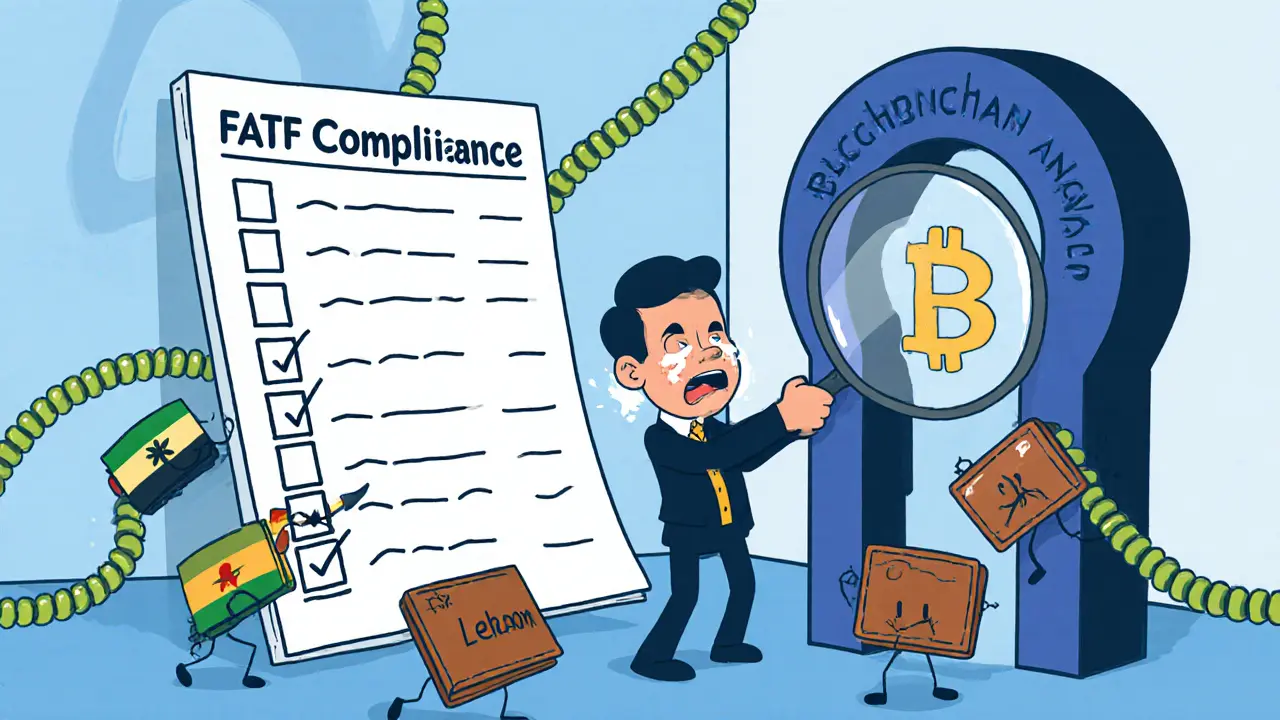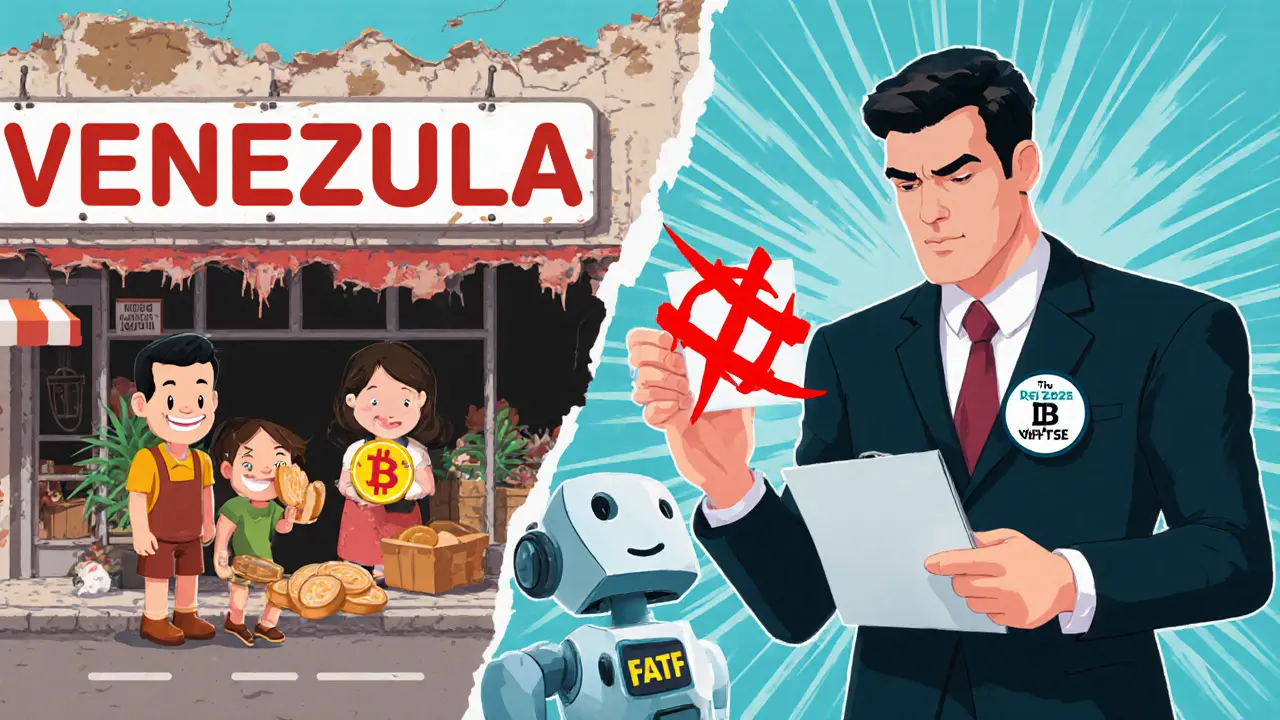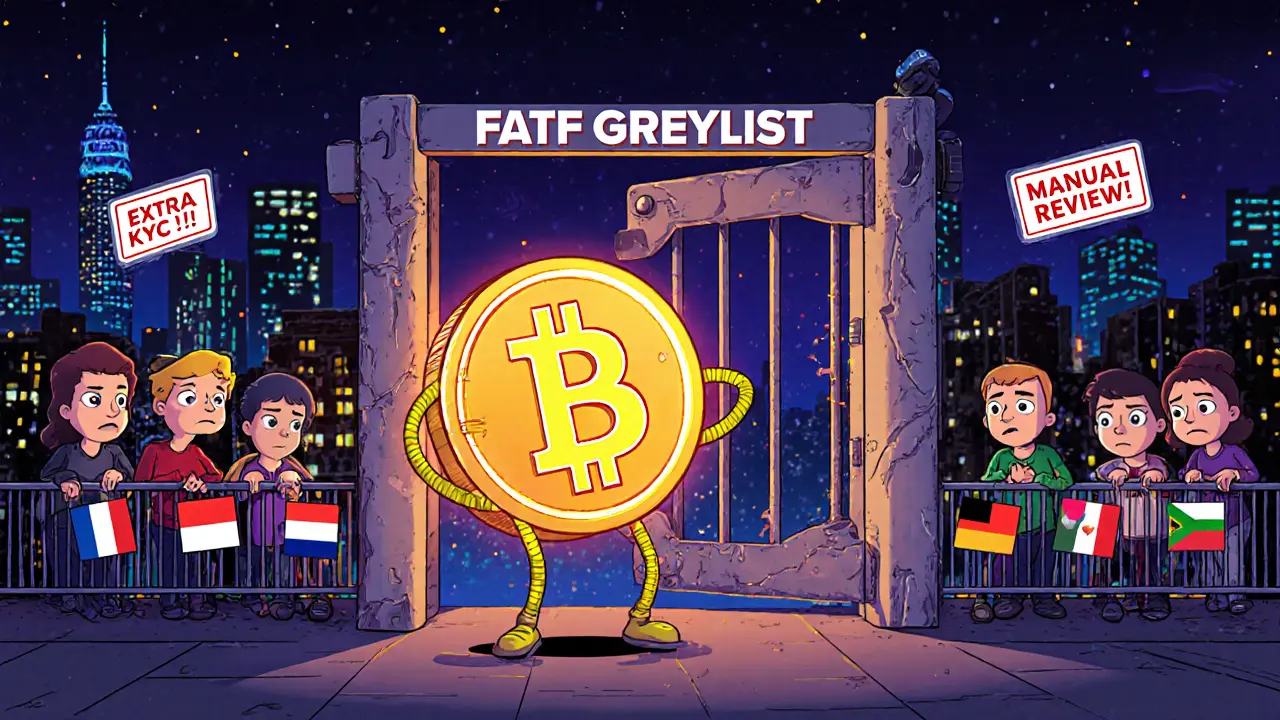When you send crypto from one country to another, you might not think about government lists. But if that crypto touches a country on the FATF greylist, your transaction could get stuck, flagged, or even blocked. This isn’t theoretical-it’s happening right now. As of June 2025, FATF greylist countries include 24 jurisdictions where crypto exchanges, wallets, and banks must apply extra scrutiny. And if you’re running a business or trading crypto across borders, ignoring this list can cost you your license, your funds, or your reputation.
What the FATF Greylist Actually Means
The Financial Action Task Force (FATF) isn’t a police force. It’s an international body that sets rules to stop money laundering and terrorist financing. When a country is put on the greylist, it means FATF has found serious gaps in its anti-money laundering (AML) and counter-terrorism financing (CTF) systems. The country isn’t banned-it’s on probation. It has to fix these problems within a set timeframe, or risk being blacklisted. The greylist isn’t a punishment. It’s a warning sign. Banks and crypto platforms look at it and say: "We need to watch this more closely." For crypto users, that means longer wait times, more ID checks, and sometimes, outright restrictions.Which Countries Are on the FATF Greylist in 2025?
As of June 2025, the FATF greylist includes these 24 countries:- Algeria
- Angola
- Bolivia
- Bulgaria
- Burkina Faso
- Cameroon
- Côte d'Ivoire
- Democratic Republic of the Congo
- Haiti
- Kenya
- Laos
- Lebanon
- Monaco
- Mozambique
- Namibia
- Nepal
- Nigeria
- South Africa
- South Sudan
- Syria
- Venezuela
- Vietnam
- Virgin Islands (UK)
- Yemen
Bolivia and the Virgin Islands (UK) were added in June 2025. Croatia, Mali, and Tanzania were removed after fixing their systems. That’s the key point: the list changes. If you’re running a crypto business, you can’t set it and forget it. You need real-time updates.
Why Crypto Exchanges Care So Much
Crypto isn’t like cash. Every transaction leaves a trail on the blockchain. But the problem isn’t the blockchain-it’s the people behind it. If a user in Nigeria sends Bitcoin to a wallet in the U.S., the exchange has to ask: "Is this person linked to a criminal network?" FATF’s "Travel Rule" requires exchanges to share sender and receiver info for transfers over $1,000. But if the recipient is in a greylist country, that’s not enough. Exchanges now need to know where the money came from, who owns the wallet, and whether the user has a history of suspicious activity. Some platforms block transfers to greylist countries entirely. Others require notarized documents, proof of income, or even video calls. This isn’t just about compliance. It’s about survival. If a crypto exchange fails to monitor greylist countries properly, it can lose its banking license. Banks refuse to work with them. Payment processors shut them down. That’s why even small exchanges in the U.S. or Europe now use automated tools that scan every transaction against the latest FATF list.
Blacklisted vs. Greylisted: What’s the Difference?
There are only three countries on the FATF blacklist: North Korea, Iran, and Myanmar. These are the real danger zones. - North Korea uses crypto to fund its weapons program. It hacks exchanges, steals millions, and washes the money through decentralized apps. U.S. and EU exchanges block all traffic to North Korean addresses. - Iran is under U.S. sanctions, but still uses crypto to bypass them. The government even created a state-backed digital currency. Most international exchanges won’t touch Iranian users-even if they’re not government-linked. - Myanmar saw a surge in crypto use after the 2021 coup. Criminal networks use it to move stolen funds. Exchanges that serve Myanmar risk being labeled enablers of financial crime. Greylist countries? They’re risky. Blacklist countries? They’re off-limits.The Real Cost of Being on the Greylist
It’s not just about crypto. When a country is greylisted, foreign investment drops. Banks stop opening accounts. Loans get harder to get. Pakistan was greylisted from 2008 to 2019. During that time, it lost an estimated $38 billion in foreign capital. That’s not a typo. $38 billion. In South Africa, the 2024 greylisting followed a wave of corruption. Eighty-two percent of citizens said corruption got worse in 2023. The government tried to fix it, but internal politics stalled reforms. Now, foreign crypto firms are pulling out. Local exchanges are struggling to find banking partners. Even Monaco-a wealthy, tiny country-is on the list. Why? Because it’s a tax haven with weak enforcement. Crypto firms using Monaco-based wallets now face extra scrutiny from European regulators.How Crypto Platforms Handle Greylist Countries
Most major exchanges-Coinbase, Kraken, Binance-don’t treat greylist countries the same way. Here’s what they typically do:- Block direct deposits from greylist countries
- Require enhanced KYC (Know Your Customer) for users from these regions
- Flag all outgoing transfers to greylist addresses for manual review
- Use blockchain analytics tools to trace wallet histories
- Update their screening systems within hours of a FATF list change
Smaller exchanges? They often don’t have the resources. Some ignore the list. Others get shut down by regulators. The ones that survive are the ones that treat FATF compliance like a core feature-not a legal afterthought.

Why Some People Still Use Crypto in Greylist Countries
You might think: if it’s so restricted, why do people still use crypto in Nigeria, Venezuela, or Lebanon? Because they have no choice. In Venezuela, the national currency lost 99% of its value in five years. People use Bitcoin to buy food. In Nigeria, the central bank banned banks from handling crypto in 2021-but usage grew anyway. In Lebanon, banks froze accounts during the financial crisis. Crypto became the only way to send money abroad. FATF wants to stop crime. But for millions, crypto is the only financial system that still works. That’s the tension. Regulations are meant to protect the system. But when the system fails regular people, they find workarounds.What Happens If You Ignore the FATF List?
Let’s say you run a small crypto exchange in Canada. You let users from Nigeria send Bitcoin to your platform. You don’t do extra checks. One day, a user sends $200,000 in crypto. The funds come from a wallet linked to a Nigerian scam operation. The Canadian Financial Transactions and Reports Analysis Centre (FINTRAC) investigates. They find you didn’t monitor the transaction properly. You’re fined $500,000. Your banking partner drops you. Your customers leave. You shut down. That’s not hypothetical. It’s happened. In 2023, a Malta-based exchange was fined $2.7 million for failing to screen users from South Africa and Lebanon. Compliance isn’t optional. It’s survival.The Future: More Rules, More Tech
FATF is working on new rules for decentralized finance (DeFi) and peer-to-peer crypto trading. Right now, most DeFi protocols don’t follow the Travel Rule. That’s changing. By 2026, FATF will likely require DeFi platforms to collect user data-even if they’re decentralized. Central Bank Digital Currencies (CBDCs) are also changing the game. Countries like China and Sweden are rolling out digital money with built-in tracking. That makes it harder to hide funds. It also makes it easier for FATF to monitor cross-border flows. The bottom line: crypto is becoming more regulated, not less. If you’re involved in crypto, you need to treat FATF compliance like oxygen. No air? No business.Are crypto transactions to greylist countries completely blocked?
No, they’re not always blocked. Most major exchanges allow transactions but apply strict monitoring. Users from greylist countries often need to submit extra documents, prove the source of funds, and may face delays. Some platforms block them entirely to avoid risk.
Can I still trade crypto if I live in a greylist country?
Yes, but it’s harder. You’ll likely face stricter KYC checks, longer verification times, and limited withdrawal options. Some platforms may refuse service. Peer-to-peer exchanges are often the only option, but they carry higher risk of scams.
How often does the FATF greylist change?
The FATF updates its lists three times a year-in February, June, and October. Changes happen when countries complete their action plans (and get removed) or when new deficiencies are found (and new countries are added). Always check the official FATF website for the latest list.
Why is Syria still on the greylist if it fixed its laws?
Syria technically met FATF’s technical requirements by 2024. But FATF can’t send inspectors to verify compliance because of the ongoing war and security risks. Until on-site visits are possible, Syria stays on the list. Political instability overrides technical compliance.
Do I need to worry about FATF if I only use crypto for personal use?
If you’re just buying Bitcoin for savings or sending small amounts to family, you probably won’t be targeted. But if you’re using a platform that serves greylist countries, your transaction could get flagged. Always use regulated exchanges-they handle compliance for you.

Comments (11)
Anthony Demarco
November 21, 2025 AT 10:40
Look I get it the FATF wants to stop crime but you think a bunch of bureaucrats in Brussels or Washington can just slap a label on a country and suddenly crypto stops flowing? That’s like trying to stop water with a sieve. Nigeria? Venezuela? People are using crypto because their banks are corrupt or their currency is trash. You wanna fix the problem? Fix the governments not punish the people trying to survive
Lynn S
November 23, 2025 AT 07:43
It is deeply concerning that so many individuals continue to conflate regulatory compliance with oppression. The FATF’s framework is not punitive-it is a necessary bulwark against systemic financial corruption that undermines global economic integrity. To dismiss it as ‘bureaucratic overreach’ is not only intellectually lazy but morally indefensible.
Jack Richter
November 25, 2025 AT 03:50
meh
Devon Bishop
November 26, 2025 AT 10:20
Just a heads up-Bulgaria was removed from the greylist in April 2025, not June. I saw the official FATF press release. Also, the Virgin Islands (UK) addition is legit but most people forget they’re a British territory so their compliance is tied to the UK’s system. If you’re a small exchange, don’t panic-just use Chainalysis or Elliptic. They update in real time and cost less than a coffee subscription. And yeah, Syria’s still on there not because they didn’t fix the laws but because no one can physically go there to verify. FATF isn’t magic, they need boots on the ground. Just saying
Khalil Nooh
November 27, 2025 AT 12:47
Listen. I used to think crypto was just about freedom. Then I lost $12k because I sent it to a Nigerian wallet and my exchange froze my account for 60 days. No warning. No explanation. Just ‘suspicious activity’. That’s the reality. The FATF isn’t the villain here. The villains are the scammers using greylist countries as laundry machines. But here’s the truth-most people in those countries aren’t criminals. They’re moms sending money to relatives, students paying tuition, small businesses buying supplies. So yeah, compliance matters. But so does compassion. We need smarter tools-not blanket bans. We can protect the system without crushing the people
Jennifer Corley
November 28, 2025 AT 21:13
Interesting how you all romanticize ‘people using crypto to survive’ while ignoring that 87% of crypto inflows into Nigeria come from known ransomware operators. You want to be the hero? Fine. But don’t pretend you’re not enabling organized crime. The fact that you think FATF is the problem shows how little you understand about financial systems. You’re not fighting oppression-you’re fighting accountability
Kaitlyn Boone
November 30, 2025 AT 13:22
lol so now its okay to let money laundering slide because some guy in Venezuela needs to buy milk? you people are so naive. the whole point of the greylist is to make it harder for criminals to hide. if you cant prove your funds are clean then you dont get to use the system. its not about being mean its about being smart. and no i dont care if you think its unfair. the world doesnt owe you access
James Edwin
November 30, 2025 AT 15:10
What about DeFi protocols? They don’t even have KYC. If FATF starts enforcing the Travel Rule on them, we’re looking at a complete overhaul of how decentralized finance works. That’s not just regulation-that’s a paradigm shift. Are we ready for that? Or are we just pretending crypto can stay wild west forever?
Kris Young
December 1, 2025 AT 14:52
It’s important to note that FATF greylisting is not a permanent designation. Countries are added when deficiencies are identified, and removed when they demonstrate sustained compliance. This process is transparent, evidence-based, and reviewed by independent experts. The list changes quarterly, and all updates are published on the official FATF website. Responsible participants in the crypto ecosystem must use verified, real-time data sources to ensure compliance. Failure to do so is not ignorance-it’s negligence.
LaTanya Orr
December 2, 2025 AT 08:08
There’s something deeper here. The FATF list isn’t just about money laundering-it’s about power. Who gets to decide what’s legitimate finance and what’s not? The same institutions that failed to prevent the 2008 crash, that let banks launder billions through shell companies, now get to say Nigeria’s crypto users are dangerous? Maybe the real problem isn’t the greylist-it’s that the global financial system was never designed to serve everyone. Crypto isn’t the threat. It’s the mirror
Ashley Finlert
December 2, 2025 AT 11:22
Let me tell you about Lagos. I was there last year. A woman sold her last goat to buy Bitcoin because her bank account was frozen for six months. She sent it to her daughter in Toronto-her only family left. The transaction took three days. Three days. Because the exchange had to call her, verify her ID, scan her utility bill, and then manually approve it. She cried when it finally went through. Now tell me-should that woman be blocked because her country is on a list written by people who’ve never seen a power outage? This isn’t compliance. This is colonialism with a blockchain interface. The FATF isn’t the solution-it’s the symptom